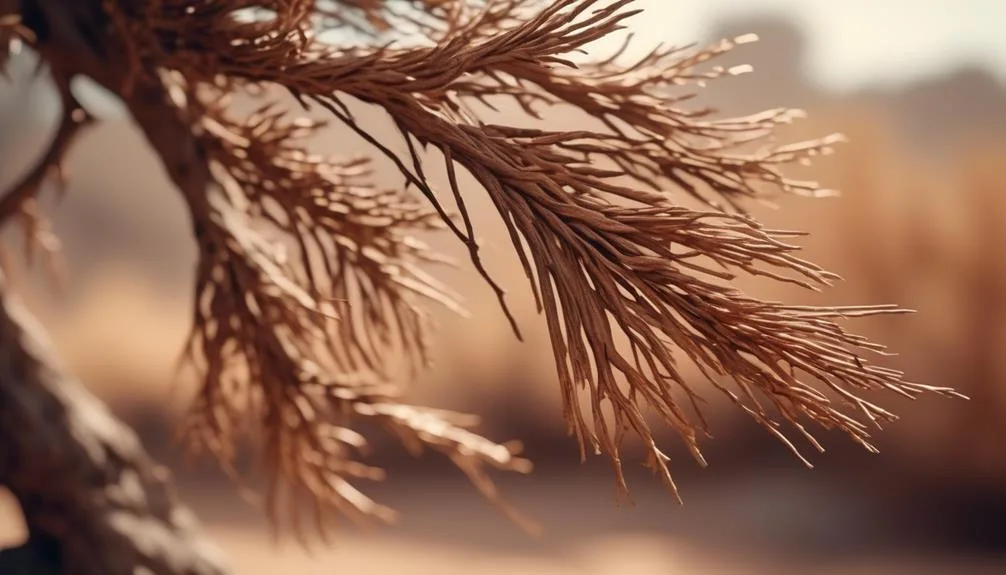Is your cedar tree suddenly turning brown and drying out, despite your efforts to care for it? There are common reasons for this, and understanding them can help you take steps to prevent further damage and revive your tree's health.
What could be causing your cedar tree to dry out, and what can you do to save it? Let's explore the possible causes and solutions to help your cedar tree thrive again.
Signs of Cedar Tree Drying Out
If you notice the cedar tree's needles turning brown and brittle, it could be a sign that the tree is drying out. This is a key indicator that the tree may not be receiving enough water.
Keep an eye on the watering frequency, as cedar trees require regular watering, especially during dry periods. Check the soil moisture by sticking your finger into the soil near the tree. If the soil feels dry to the touch, it's likely that the tree isn't getting enough water.
Ensure that the soil is consistently moist but well-drained to support the cedar tree's health. By monitoring the watering frequency and soil moisture, you can prevent the cedar tree from drying out and maintain its vibrant, healthy appearance.
Common Causes of Cedar Tree Drying
To understand the common causes of cedar tree drying, it's important to consider various factors that can contribute to the tree's moisture depletion.
- Soil Moisture:
- Inadequate drainage can lead to waterlogged soil, suffocating the roots and causing the tree to dry out.
- Drought conditions can significantly reduce soil moisture, affecting the tree's ability to uptake water and nutrients.
- Pest Infestation:
- Certain pests, such as bark beetles, can infest cedar trees, disrupting the flow of nutrients and water, ultimately leading to drying out.
Understanding these common causes can help you take proactive measures to ensure your cedar tree remains healthy and well-hydrated. Regularly monitor soil moisture levels and promptly address any signs of pest infestation to maintain the vitality of your cedar tree.
Environmental Factors Affecting Cedar Trees
Understanding the impact of environmental factors on cedar trees is essential for maintaining their health and preventing issues such as drying out, caused by soil moisture depletion and pest infestations.
The soil composition and water availability play a crucial role in the health of cedar trees. Cedar trees thrive in well-draining soil with moderate moisture levels. Compacted or waterlogged soil can lead to root suffocation and drying out.
Additionally, sun exposure and temperature fluctuations can affect cedar trees. They prefer full sun, but excessive heat can lead to water loss and stress, contributing to drying out. Sudden temperature fluctuations, especially in winter, can also harm cedar trees.
Monitoring and maintaining appropriate soil moisture, drainage, and sun exposure are vital for preventing cedar trees from drying out.
Preventive Measures for Cedar Tree Health
Maintain proper soil moisture levels and ensure adequate drainage to keep your cedar trees healthy and prevent drying out.
To further enhance the health of your cedar trees, consider the following preventive measures:
- Pruning Techniques:
- Regularly prune dead or diseased branches to promote air circulation and reduce the risk of fungal infections.
- Use proper pruning techniques to maintain the natural shape and integrity of the cedar tree while removing any damaged or overcrowded branches.
Expert Tips for Cedar Tree Care
Consider seeking advice from certified arborists for expert tips on caring for your cedar trees and maintaining their health and vitality. Proper pruning techniques and a well-maintained watering schedule are crucial for the well-being of your cedar trees. Here are some expert tips to ensure the optimal care for your beloved cedars:
| Expert Tips for Cedar Tree Care |
|---|
| Pruning Techniques |
| Regularly prune dead or diseased branches to promote healthy growth and prevent the spread of disease. Avoid heavy pruning during the fall to protect the tree from winter damage. |
| Watering Schedule |
| Deeply water young cedar trees every 7-10 days during dry periods. Mature cedars require watering every 10-14 days. Ensure the soil is well-drained to prevent waterlogging and root rot. |
| Soil Maintenance |
| Use organic mulch to retain soil moisture and control weeds. Avoid mulch directly touching the trunk to prevent rot. |
Following these expert tips will help your cedar trees thrive and remain vibrant for years to come.
Conclusion
In nurturing your cedar tree, remember to stay mindful of environmental factors and implement expert tips for its care.
With dedicated attention, you can ensure the long-term health and vibrancy of your cedar tree.
Happy tree-tending!

My interest in trees started when I first saw the giant sequoias in Yosemite.
I was a teenager then, and I remember thinking, “I need to learn more about this.”
That moment stuck with me.
A few years later, I went on to study forestry at Michigan Tech.
Since graduating, I’ve worked in a mix of hands-on tree care and community education.
I’ve spent over ten years helping people understand how to plant, maintain, and protect the trees in their neighborhoods.
I don’t see trees as just part of the landscape.
They are living things that make a real difference in our daily lives.
